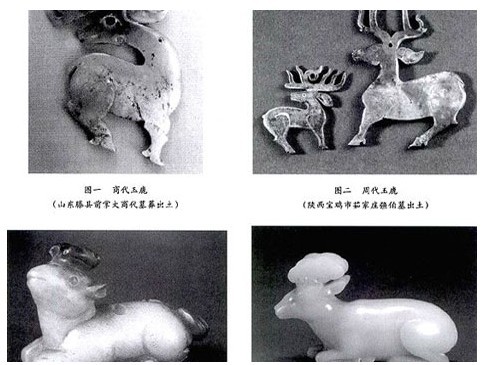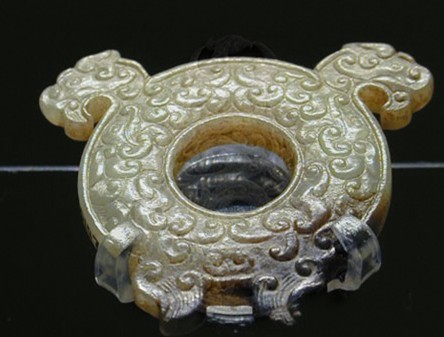| Home > China Feature |
Jade in China

Jade is a stone ingrained in Chinese art, culture and history, stretching 9,000 years back into the ancient and enormous Chinese empire. Jade has always been a special stone, used not just for fine objects but also as material for grave goods for the imperial family. It is believed to be a link between both the physical and the spiritual worlds, and is the only material that completely encapsulates both the yin and yang qualities of Heaven and Earth, earning it the moniker The Stone of Heaven.
History of Jade
Jade mines in China have long been depleted, but the association and love for this stone endures with the Chinese. Jade is also found in Burma, Central America, Brazil, Canada and India. Although prized by other civilisations as well as the Chinese, no other culture can rival China for the richness and intricacy of the jade rings, bracelets, beads and pendants found there.
The Chinese have been working jade since the Neolithic period, to the present. Discs and tubes made of jade found in Neolithic Chinese graves are the earliest indication of this stone's association with the otherworldly. By 200 B.C., when the Book of Songs was written during the Zhou dynasty, the stone was established as an aid to immortality. It would continue to be used in burial rituals well into the Han Dynasty.

During the Shang Dynasty (1600 B.C. to 1050 B.C), jade was used for personal adornment by kings, as well as for utilitarian and ceremonial objects. Jade knives, daggers and objects imbued with royal meanings like sceptres and jade burial suits have been found in tombs most likely used for ritual or military ceremonies. A record from a 200 A.D Chinese dictionary defines jade as the fairest of stones, endowed with five virtues charity, rectitude, wisdom, courage and equity. Towards the end of the Tang Dynasty however, funerary practises changed and by the time the modern Ming and Qing dynasties rolled around in the 16th century, the stone had become more referential and was primarily used as material for objets d'art of the imperial court.
The Qualities of Jade
This milky green stone is seen as a metaphor for human virtues because of its hardness, durability and beauty. Confucius, the Chinese philosopher, famously said the good virtue of man is like jade. It represents dignity, blessing, fortune and longevity. White jade is the most highly valued, but the stone comes in a variety of translucent shades of green, brown and black.
In China
the term jade is actually used to encompass several different minerals which include serpentine and aventurine which are not true types of jade. There are only two distinct stones that are true jades nephrite and jadeite. Both these tones share many qualities, but jadeite has a greater range of colours. The hardness and brittleness of jade requires great skill to craft, but great intricacy can be accomplished with this stone.
Coupled with its high lustre and translucency, jade is a gemstone that is much sought after. A Chinese proverb attributes greater attachment to jade than to gold, as gold has value, but jade is invaluable.
Jade and Superstition
This imperial gem of both Heaven and Earth has always been empowered with magical properties, at least in the minds of the Chinese. Taoist alchemist believed it to be the Philosopher's Stone, and drank elixirs of powdered jade. Jade was also considered a guardian against illness and evil spirits, which is why even babies in China are given a tiny jade bangle to wear to ward off bad luck. In the Han dynasty, emperors were buried in jade gowns and jade cicadas were placed on dead kings' tongues to prevent decomposition and safeguard chi or energy.
Culturally, jade stands for beauty, grace and purity. It is often referred to as a live stone due to its propensity to change colour. Many Chinese believe that if the stone likes the wearer, it will grow a deeper, darker shade of green. Many pieces of jade jewellery do change colour over time, and believers who wear it for protection and good luck attribute this to the absorption of bad chi that would otherwise have affected the wearer. Jade is also supposed to improve blood circulation and calm the mind.
Modern Use
Traditionally, many Chinese family heirlooms have at least one piece of jade in their trove, often a jade bangle passed down from mother to daughter. Jade is still worn as a deterrent of bad luck but it is also finding its place as a relevant gem in the fashion and jewellery industries. Popular in Hong Kong as well as China, modern designs of jade combine both cutting edge design and cultural reference to an ancient heritage.
Art
 more
moreChina Beijing International Diet ...
Recently, The hit CCTV documentary, A Bite of China, shown at 10:40 ...

Exhibition of Ancient Chinese Jad...
At least 8,000 years ago, Chinese ancestors discovered a beautiful...

Longmen Grottoes
The Longmen Grottoes, located near Luoyang, Henan Province, are a tr...

Custom
 more
moreWeb Dictionary
Martial Arts
Tai Chi Master Class Held in Moscow
MOSCOW, June 15, 2016 (Xinhua) -- Students learn from Shaolin ...
Celebriting 70 years' efforts in restoring Mogao...
Work is being carried out at the restoration site of cave No 98 a...
Hong Kong Children's Symphony performs in Seattle
Under the theme of Tribute to the Golden Age, a concert featuring a ...





 print
print  email
email  Favorite
Favorite  Transtlate
Transtlate 








